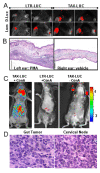T-cell activation promotes tumorigenesis in inflammation-associated cancer
- PMID: 20017942
- PMCID: PMC2806367
- DOI: 10.1186/1742-4690-6-116
T-cell activation promotes tumorigenesis in inflammation-associated cancer
Abstract
Chronic inflammation has long been associated with a wide range of malignancies, is now widely accepted as a risk factor for development of cancer, and has been implicated as a promoter of a variety of cancers including hematopoietic malignancies. We have described a mouse model uniquely suited to examine the link between inflammation and lymphoma in which the Tax oncogene, expressed in activated T and NK cells, perpetuates chronic inflammation that begins as microscopic intraepithelial lesions and develops into inflammatory nodules, subcutaneous tumors, and large granular lymphocytic leukemia. The use of bioluminescent imaging in these mice has expanded our ability to interrogate aspects of inflammation and tumorigenesis non-invasively. Here we demonstrate that bioluminescence induction in these mice correlated with inflammation resulting from wounding, T cell activation, and exposure to chemical agents. In experiments in which long-term effects of inflammation on disease outcome were monitored, the development of lymphoma was promoted by an inflammatory stimulus. Finally we demonstrated that activation of T-cells in T-cell receptor (TCR) transgenic TAX-LUC animals dramatically exacerbated the development of subcutaneous TCR- CD16+ LGL tumors. The role of activated T-cells and acquired immunity in inflammation-associated cancers is broadly applicable to hematopoietic malignancies, and we propose these mice will be of use in dissecting mechanisms by which activated T-cells promote lymphomagenesis in vivo.
Figures





Similar articles
-
p53 dysfunction precedes the activation of nuclear factor-κB during disease progression in mice expressing Tax, a human T-cell leukemia virus type 1 oncoprotein.Carcinogenesis. 2013 Sep;34(9):2129-36. doi: 10.1093/carcin/bgt144. Epub 2013 Apr 30. Carcinogenesis. 2013. PMID: 23633516
-
A Unique T-Cell Receptor Amino Acid Sequence Selected by Human T-Cell Lymphotropic Virus Type 1 Tax301-309-Specific Cytotoxic T Cells in HLA-A24:02-Positive Asymptomatic Carriers and Adult T-Cell Leukemia/Lymphoma Patients.J Virol. 2017 Sep 12;91(19):e00974-17. doi: 10.1128/JVI.00974-17. Print 2017 Oct 1. J Virol. 2017. PMID: 28724766 Free PMC article.
-
Imaging spontaneous tumorigenesis: inflammation precedes development of peripheral NK tumors.Blood. 2009 Feb 12;113(7):1493-500. doi: 10.1182/blood-2008-07-166462. Epub 2008 Oct 29. Blood. 2009. PMID: 18971418 Free PMC article.
-
Adult T-cell leukemia-lymphoma as a viral disease: Subtypes based on viral aspects.Cancer Sci. 2021 May;112(5):1688-1694. doi: 10.1111/cas.14869. Epub 2021 Mar 30. Cancer Sci. 2021. PMID: 33630351 Free PMC article. Review.
-
Human T-cell lymphotropic virus: a model of NF-κB-associated tumorigenesis.Viruses. 2011 Jun;3(6):714-49. doi: 10.3390/v3060714. Viruses. 2011. PMID: 21743832 Free PMC article. Review.
Cited by
-
Low concentration of S100A8/9 promotes angiogenesis-related activity of vascular endothelial cells: bridges among inflammation, angiogenesis, and tumorigenesis?Mediators Inflamm. 2012;2012:248574. doi: 10.1155/2012/248574. Epub 2012 May 17. Mediators Inflamm. 2012. PMID: 22685372 Free PMC article.
-
Animal Models Utilized in HTLV-1 Research.Virology (Auckl). 2013 Nov 18;4:49-59. doi: 10.4137/VRT.S12140. eCollection 2013. Virology (Auckl). 2013. PMID: 25512694 Free PMC article. Review.
-
Human T-cell leukemia virus type 1 (HTLV-1) and leukemic transformation: viral infectivity, Tax, HBZ and therapy.Oncogene. 2011 Mar 24;30(12):1379-89. doi: 10.1038/onc.2010.537. Epub 2010 Nov 29. Oncogene. 2011. PMID: 21119600 Free PMC article. Review.
-
Ubiquitin-specific peptidase 20 targets TRAF6 and human T cell leukemia virus type 1 tax to negatively regulate NF-kappaB signaling.J Virol. 2011 Jul;85(13):6212-9. doi: 10.1128/JVI.00079-11. Epub 2011 Apr 27. J Virol. 2011. PMID: 21525354 Free PMC article.
-
Inflammation promotes oral squamous carcinoma immune evasion via induced programmed death ligand-1 surface expression.Oncol Lett. 2013 May;5(5):1519-1526. doi: 10.3892/ol.2013.1238. Epub 2013 Mar 8. Oncol Lett. 2013. PMID: 23761816 Free PMC article.
References
Publication types
MeSH terms
Substances
Grants and funding
LinkOut - more resources
Full Text Sources

